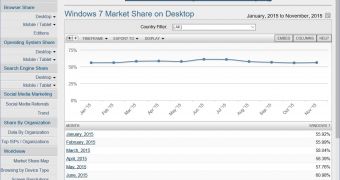Earlier this year, Microsoft took everyone by surprise and announced that Windows 10 would be offered free of charge to those running Windows 7 or 8.1 on their computers.
The offer was supposed to be available for only 12 months after the launch of Windows 10, and everyone believed this to be an excellent starting point for the first Windows version offered for free in the history of Microsoft.
Only that, despite the big push that Microsoft's making with Windows 10, the majority of Windows 7 users don't really seem to be interested in the free upgrade, and market share data shows that only a few have actually moved to the new OS from this particular version.
Windows 7 going back up
Back in July 2015, when Windows 10 finally came to be, Windows 7 was powering 60.73 percent of the world's desktop computers. Moreover, it's worth noting that, despite the arrival of the new version on the same month, it managed to achieve a record share in June, when it almost reached 61 percent.
In August, however, the arrival of Windows 10 indeed caused a drop, and Windows 7 fell to 57.67 percent, with the decline continuing in September and October, when it reached 56.53 and 55.71 percent, respectively.
But in November, some of those who previously jumped ship returned to Windows 7, so its market share increased to 56.11 percent, which is even bigger than the one in January 2015, when this OS was running on 55.92 percent of the world's PCs.
Overall, Windows 7 lost only 4.62 percent of its users after the arrival of Windows 10, despite the huge expectations that Microsoft had before the launch. What's worse is that people seem to go back to Windows 7 these days, and they're using the 30-day downgrade window that allows them to give up on Windows 10 without losing their files and apps.
Hopefully, Windows 10 adoption will continue to increase in the coming year, but it'll be interesting to see how Microsoft manages to reach its 1 billion devices running Windows 10 goal with this performance that's clearly full of ups and downs.

 14 DAY TRIAL //
14 DAY TRIAL //